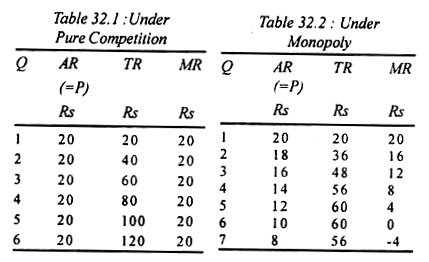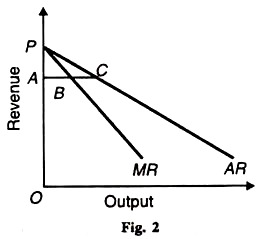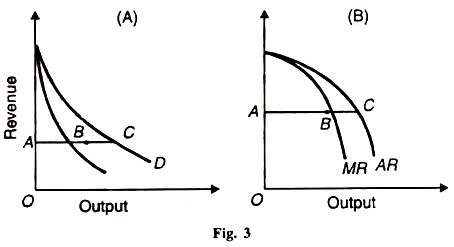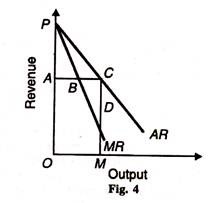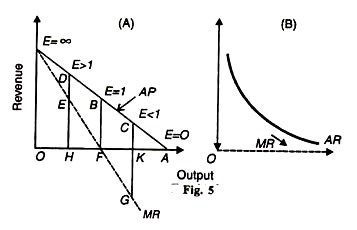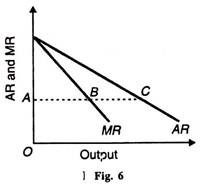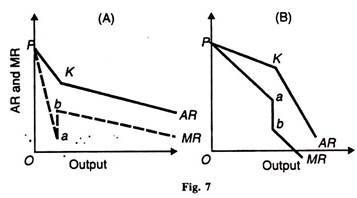Learn about the relationship between AR and MR Curves.
The relation between average revenue and marginal revenue can be discussed under pure competition, monopoly or monopolistic competition or imperfect competition.
(1) Under Pure Competition:
ADVERTISEMENTS:
The average revenue curve is a horizontal straight line parallel to the X-axis and the marginal revenue curve coincides with it. This is because under pure (or perfect) competition the number of firms selling an identical product is very large.
The price is determined by the market forces of supply and demand so that only one price tends to prevail for the whole industry, as shown in Table 1. It is OP, as shown in Panel (A) of Figure 1. Each firm can sell as much as it wishes at the market price OP.
Thus the demand for the firm’s product becomes infinitely elastic. Since the demand curve is the firm’s average revenue curve, the shape of the AR curve is horizontal to the X-axis at price OP, as shown in Panel (B) and the MR curve coincides with it. This is also shown in Table 1 where AR and MR remain constant at Rs.20 at every level of output. Any change in the demand and supply conditions will change the market price of the product, and consequently the horizontal AR curve of the firm.
(2) Under Monopoly or Imperfect Competition:
ADVERTISEMENTS:
The average revenue curve is the downward sloping industry demand curve and its corresponding marginal revenue curve lies below it. The relation between the average revenue and the marginal revenue under monopoly can be understood with the help of Table 2.
The marginal revenue is lower than the average revenue. Given the demand for his product, the monopolist can increase his sales by lowering the price, marginal revenue also falls but the rate of fall in marginal revenue is greater than that in average revenue In Table 2 AR falls by Rs.2 at a time, whereas MR falls by Rs.4.
This is shown in Figure 2 in which the MR curve is below the AR curve and lies halfway on the perpendicular drawn from AR to the Y-axis. This relation will always exist between straight line downward slopping AR and MR curves.
In case the AR curve is convex to the origin as in Figure 3 (A), the MR curve will cut any perpendicular from a point on the AR curve at more than half-way to the Y-axis. MR passes to the left of the mid-point В on the CA. On the other hand, if the AR curve is concave to the origin, MR will cut the perpendicular at less than half-way towards the Y-axis. In Figure 3 (B), MR passes to the right of the mid-point В on the CA.
AR, MR and Elasticity:
However, the true relationship between the AR curve and its corresponding MR curve under monopoly or imperfect competition depends upon the elasticity of the AR curve. We know that elasticity at point С in Figure 4 is
E= = CM/ PA =CM/CD (PA= CD being the sides of similar ∆s)
On the basis of this formula, the relationship between AR and MR is explained in terms of the Figure 5 (A). At point B on the average revenue curve, PA, the elasticity of demand is equal to 1. According to the formula,
MR = AR 1-1/1 = AR 0/1 = 0
The MR curve is zero when it touches the X-axis at point F. Thus, where elasticity of AR curve is unity, MR is always zero
ADVERTISEMENTS:
In case the elasticity of the AR curve is unity throughout its length like a rectangular hyperbola, the MR curve will coincide with the X-axis, shown as a dotted line in Figure 5 (B).2
If the elasticity of the AR curve at point D is greater than unity, say 3, MR = AR -3-1/3= 2/3. It shows that when the elasticity of AR is greater than one, MR is always positive. It is EH in Figure 5 (A).
Where the elasticity of the AR curve is less than unity, say 1/2, MR
ADVERTISEMENTS:
= AR= ½ -1/ ½ = -½/ ½ = -1. It shows MR to be negative. At point С on the AR curve, elasticity is less than unity and MR is negative KG. If the elasticity of AR is infinity (E = ∞), MR coincides with it at point P in Figure 5 (A). Lastly, when the elasticity of the AR curve is zero, the gap between AR and MR curves becomes wider and MR lies much below the X-axis.
(3) Monopolistic Competition:
Under monopolistic competition, the relationship between AR and MR is the same as under monopoly. But there is an exception that the AR curve is more elastic, as shown in Figure 6. This is because products are close substitutes under monopolistic competition. The firm can increase its sales by a reduction in its price.
ADVERTISEMENTS:
(4) Under Oligopoly:
The average and marginal revenue curves do not have a smooth downward slope under oligopoly. They possess kinks. Since the number of sellers under oligopoly is small, the effect of a price cut or price increase on the part of one seller will be followed by some changes in the behaviour of other firms. If a seller raises the price of his product, the other sellers will not follow him in order to earn larger profits at the old price.
So the price-raising seller will experience a fall in the demand for his product. His average revenue curve in Figure 7 (A) becomes elastic after К and its corresponding MR curve rises discontinuously from a to b and then continues its course at the new higher level.
On the other hand, if the oligopolistic seller reduces the price of his product, his rivals also follow him in reducing the prices of their products so that he is not able to increase his sales. His AR curve becomes less elastic from К onward, as in Figure7 (B). The corresponding MR curve falls vertically from a to b and then slopes at a lower level.
